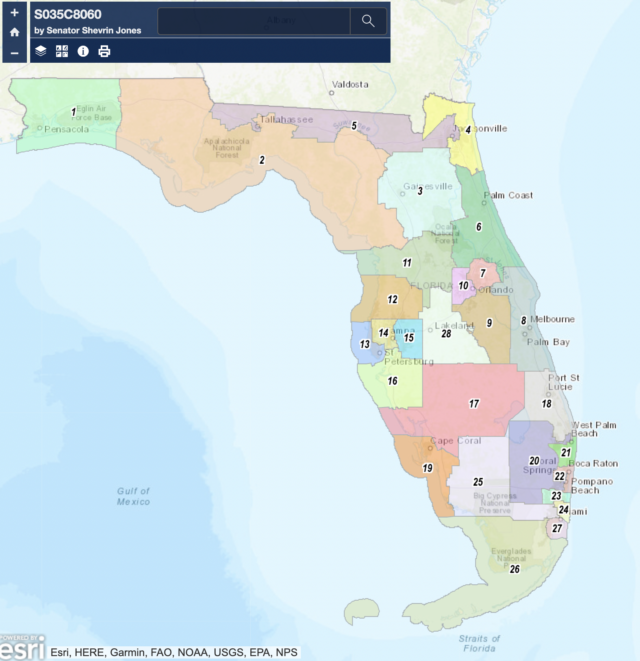
The Florida Senate approved a congressional redistricting plan to divide Florida into 28 congressional districts.
With a 31-4 vote, the plan (S 8060) became the first map approved by a chamber of the Florida Legislature during the once-a-decade redistricting process.
Liberal advocacy groups like Latino Justice have promised lawsuits over a failure to increase Florida’s number of minority access districts. Meanwhile, Republican Gov. Ron DeSantis’ office has criticized at least one district as an “unconstitutional gerrymander,” and online activists have called on the Florida House to ignore the Senate map or for DeSantis to veto it.
That said, many third-party observers have generally praised the Senate process. Senate Reapportionment Committee Chair Ray Rodrigues, an Estero Republican, has prioritized working within the boundaries of the law. The Princeton Gerrymandering Project, for example, gave draft maps a B grade.
“Let me be clear, I am not saying today that this is the only map that can be drawn to be compliant,” Rodrigues said. “But what I am saying is that the map before us today fulfills the charge that the [Senate] President gave the reapportionment committee: to deliver a map designed to be compliant with our Florida Constitution and with all federal and state statutes.”
The chamber prioritized adherence to the Fair Districts amendment in Florida’s Constitution and to the federal Voting Rights Act, while also remaining mindful of legal pitfalls that led to a map produced by the Legislature in 2012 being thrown out.
The Florida Supreme Court in 2015 tossed the congressional map approved by the Florida Legislature based on evidence that special interests submitted planted maps as public submissions, and those resulted in a map that illegally favored Republicans.
A performance analysis by MCI Maps found in 16 of the proposed new congressional districts, a majority of voters supported Republican Donald Trump in the 2020 election, while the other 12 districts favored Democrat Joe Biden. Similarly, the Princeton Gerrymandering Project found the map would most likely produce 16 Republican U.S. Representatives and 12 Democratic ones.
Right now, Florida’s U.S. House delegation includes 16 Republicans and 11 Democrats.
The biggest geographic debate has centered around the districts in Tampa Bay. Under the current map, Florida’s 14th Congressional District, represented by Democratic U.S. Rep. Kathy Castor, remains bound within Hillsborough County and includes most of Tampa. But the new map splits the major city and shifts Castor’s district across the Pinellas County line.
More recently, the Governor’s Office has labeled Florida’s 5th Congressional District, represented by Democratic U.S. Rep. Al Lawson, an illegal gerrymander. The district, which spans from Tallahassee to Jacksonville, was introduced when the Florida Supreme Court replaced the Legislature’s 2012 map with a submission from the League of Women Voters of Florida and Common Cause. Every Senate draft map considered during the reapportionment process has included a district analogous to Lawson’s.
Lawson and Sen. Bobby Powell, chair of the Florida Legislative Black Caucus, have both said it’s critical to protect the minority access district, one of four predominantly Black districts that appear on the Senate’s congressional map. Rodrigues said on Wednesday the Senate prioritized maintaining Black and Hispanic districts to avoid any diminishment in minority access.
Another priority was keeping cities and counties whole and adhering to existing political and geographic boundaries. An amendment presented by Sen. Shevrin Jones, a Miami Gardens Democrat, was approved on Wednesday and focused on that goal. The amendment marked the last change to maps before Senate passage.
The Florida House hasn’t moved as quickly to pass its own congressional map but will do so before the end of the 2022 Legislative Session. The chambers must then come together on a map both chambers will approve. DeSantis may sign or veto the congressional maps passed by the full Legislature, and the maps must undergo court review before they go into effect this year. The maps should be in place for the 2022 election cycle.
Ultimately, four Democrats voted against the map and all Republicans favored it. One seat in the chamber remains vacant and some members are out sick.
Sens. Victor Torres and Janet Cruz, both Democrats who identify as Hispanic, cast votes against the map citing concerns about minority representation. Both argued the massive growth in Hispanic voters in Central Florida warranted a new Hispanic opportunity district there. Instead, Florida’s new district — awarded by the 2020 Census — was placed in east Hillsborough County and filled primarily with White voters.
“As a result of these concerns, I believe these maps may not pass muster under the Tier 1 standards required by the Florida Constitution and could also be challenged under protections afforded by federal voting rights,” Torres said.
Rodrigues argued the Hispanic growth occurred in existing Hispanic communities. An opportunity district in the maps implemented in 2015, Florida’s 9th Congressional District, has now become majority Hispanic for example.





One comment
Matthew Lusk
January 21, 2022 at 9:17 am
S 8060 is a racist map. CD 5 forces Blacks to take a “free handout” they or others may not want. “Access” is a vague unaplicable quasi legal term. The Constitution is color blind. There are no no race special privileges to guarantee special access or a guaranteed House seat. How racist would that be? The DeSantis map is superior because it uses disinterested geography and compactness to determine district lines. True the lines have to be drawn somewhere but the long contorted district 5 screams racism. Some Democrats do not understand racism when it comes from them!
Comments are closed.